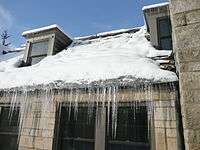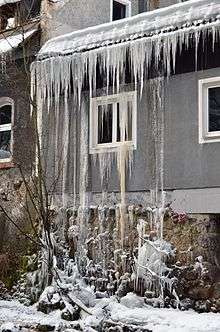Ice dam (roof)

An ice dam is an ice build-up on roofs of buildings which may cause water damage to the building and contents if the water leaks through the roof.
Overview

An ice dam is a problem of house and building maintenance on sloping roofs in cold climates. Ice dams on roofs form when accumulated snow on a sloping roof melts and flows down the roof, under the insulating blanket of snow, until it reaches below freezing temperature air, typically at the eaves. When the meltwater reaches the freezing air, ice accumulates, forming a dam, and snow that melts later cannot drain properly through the dam.[1] Ice dams may result in leaks through the roofing material, possibly resulting in damaged ceilings, walls, roof structure and insulation, damage or injury when the ice dam falls off or from attempts to remove ice dams.
The melting of roof snow comes from two reasons: Heat from inadequate roof insulation and heat leaks, and inadequate ventilation. This condition is called a warm roof and the heat conducted through the roof melts snow on those areas of the roof that are above heated living spaces, but the snow does not melt on roof overhangs.[2] Ice Dams and related leaks are not the result of faulty roofing material. Also, a small amount of ice damming can occur from the normal freeze-thaw cycle melts snow on warm or sunny days. This snowmelt continues to run down the roof on cold nights and freezes when it contacts the cold air.[3]
Damage prevention
Various methods are taken to prevent damage from ice damming:[4][5]
- In new construction, ice dams are easily prevented through building designs with adequate insulation and roof ventilation. Existing roofs may allow the addition of more insulation and mechanical ventilation. Research into ice damming conditions determined that ice damming occurs when the attic temperature is above 30 °F (−1 °C) and the outdoor air temperature is below 22 °F (−6 °C). Attic/roof temperatures can be controlled by installing sufficient insulation and providing natural or mechanical ventilation to produce a "cold roof" to keep the roof temperature below 30 °F (−1 °C).[3]
- Removal of snow from a roof with a special tool called a roof rake. To be successful, the entire roof must be shoveled. Shoveling part way up a roof will cause an ice dam to form at the location where the snow was left, because the meltwater will freeze when it hits the freezing air.[3] Many roofs are too tall to reach from the ground and must be shoveled from a ladder or by walking on the roof, which increases the risk of personal injury or roof damage.
- Use a roofing material which sheds snow, such as a metal roof, with adequate roof pitch and minimal valleys.
- Removal of ice buildup on a roof can be completed by trained professionals that use special steam equipment to ensure quick and safe removal without causing damage to the roof.
- A roofing membrane, required by building codes in the United States, installed under the roofing material helps prevent leakage from ice damming, but has no effect on the formation of ice dams.[1]
- An ice belt, a band of metal roofing, installed at the eaves helps prevent the formation of ices dams by placing a low-friction surface where ice dams are likely to form. If an ice dam does form, an ice belt will reduce the penetration of standing water.[1]
- Heat tape installed at the eaves melts channels for the water to flow through. However, there are many criticisms of heat tapes including expense, wasted energy, long-term damage to asphalt shingles, and risk of fire. Some insurance companies will not allow the use of heat tapes due to the fire danger.[6] Ice dams can also form just above the heat tape.[1] Heat tapes are a common way to keep gutters and downspouts from icing.
- Ice melt socks: A manufactured, permeable material (the sock) filled with ice melt placed on the ice dam will lower the freezing point of the ice, thus causing it to melt.
References
| Wikimedia Commons has media related to Ice dams (roof). |
- 1 2 3 4 Paul Fisette, "Preventing Ice Dams", Roofing, flashing & waterproofing. Newtown, CT: Taunton Press, 2005. 54.
- ↑ Ice Dams, Minnesota Department of Commerce, archived from the original on 2007-08-24
- 1 2 3 Hansen, Erik. Snow engineering: recent advances and developments: proceedings of the Fourth International Conference on Snow Engineering: Trondheim, Norway, 19–21 June 2000. Rotterdam: A.A. Balkema, 2000. 219.
- ↑ "Condensation and Ice Damming on a Metal Roof". Absolute Steel. 3 April 2014. Retrieved 25 September 2014.
- ↑ Fisette, Paul (2011). "Preventing Ice Dams". University of Massachusetts Amherst. Retrieved 29 September 2014.
- ↑ Gordon Bock, "Frost in the Rafters, Ice on the Eaves: How to Deal With Winter Moisture". Old-House Journal. vol. XXI no. 6. November–December 1993. 32-34.